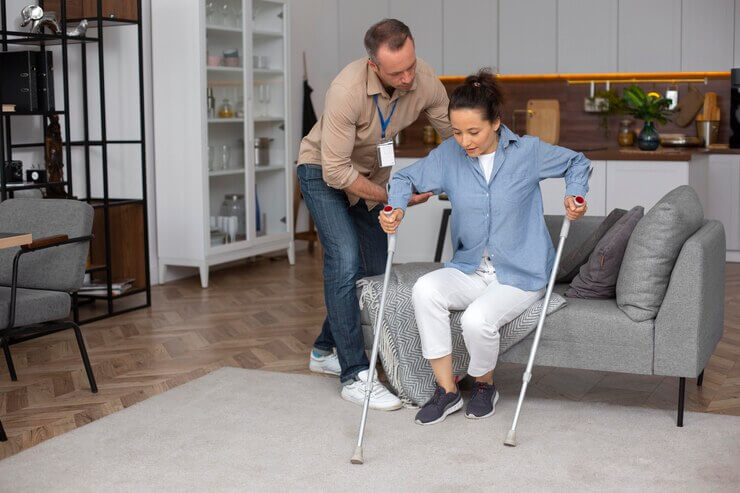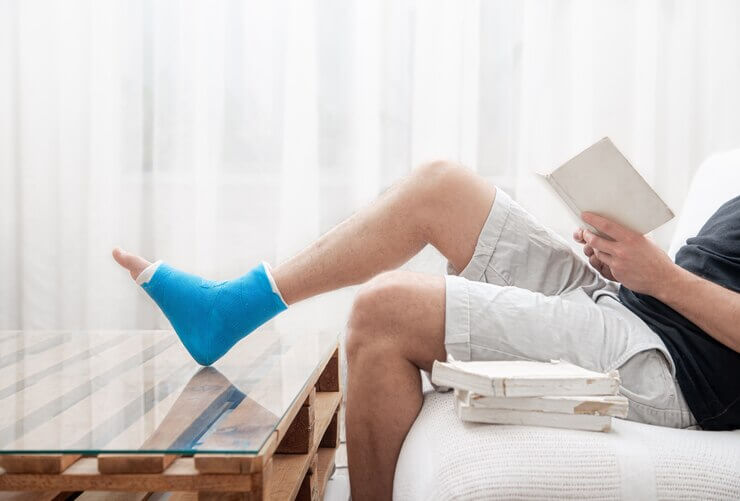If you have a blockage or contraction of the arteries supplying your legs, blood flow will decrease, leading to potential leg amputation. You may feel pain in your feet, wake up at night, or notice ulcers or black spots on your fingers, feet, or legs. If you do not address arterial disease, it can severely restrict blood circulation, causing foot tissue damage due to oxygen and nutrient deficiencies, which can result in infections and burns.
In some cases, burns can be very dangerous if the infection spreads to the body and can be life threatening. If you’ve suffered these symptoms due to an injury, a hit and run accident lawyer can assist you in seeking proper compensation. Leg Amputation is always a last resort and is recommended only if your surgeon decides that it is not possible to improve the blood circulation in any other way.
The main areas of amputation are:
By the knee
By the thigh
The Leg amputation site depends on how much blood you have brought to the leg. If possible, amputations are performed below the knee because it is easier to go to the artificial limb after surgery. However, many people are good after cutting the thigh.
The following information explains the method of cutting a leg.Before your surgery, you usually receive one to two days before your surgery. You will be taken to bed by one of the nurses. who also reports your personal information in your care records.
Several tests must be done to verify that you are fit for surgery. These included:
X-rays of the arteries (arteriogram) to see where the blockages are
Pulmonary radiography
blood tests
ECG (heart trace)
breath test
Please bring the medicines you are currently taking.
The surgeon will take care of your operation and the doctor who will administer the anesthesia. They decide where the leg is cut for the Leg Amputation. For questions about surgery, please contact the doctors.Operation: In the anesthesia room, you will receive a general anesthesia to sleep. You can also insert a tube in the back that can be used to transmit pain relief to lower the lower body while remaining (spine or epidural).
The anesthetist may also use a complete epidural narcotic to treat pain after surgery.While you sleep, the tubes are placed in your bladder to drain your urine and vein from your arm or neck (or both) to measure blood pressure and deliver fluid after surgery. The amputation stump is often closed with undamaged skin that dissolves, and sometimes a slight drainage to drain after the accumulation of fluid. A clear plastic dressing may be used to perform stump inspection, but sometimes a dressing or plaster is used.
After Leg Amputation surgery, you will usually return to the service as soon as you receive the anesthetic. Sometimes an anesthesiologist sends you to postoperative surgery (POSU) or dependent surgery (HDU) to monitor your progress more closely. You get a liquid from a drop in one of your veins until you are healthy enough to get up and receive liquid and food through your mouth.
Nurses and doctors will try to protect your pain by providing pain medication by injection, a tube in the back, or a machine that you can control yourself at the touch of a button.Pain often occurs when you feel it is a part of the leg that has been removed (a ghost disease). It can be treated with drugs and disappear quickly. You may also need a small blood transfusion. When you return, different tubes are removed and become progressively more mobile until you are fit enough to go home.
The physiotherapist will visit you before and after your operation to help you with your breath (to prevent the development of a breast infection) and your mobility. At first you will show the workouts on the bed, then you will be asked to move from your bed to a chair.When your wound is healed, the physiotherapist starts walking with a temporary artificial limb, knowing that you feel safe wearing it. Otherwise, you will learn how to use.

When you return home after a Leg Amputation , you may need to make changes to your home before you can get fired. In some cases, you may need to move to another residence. If you leave the hospital, you should continue to go to the physiotherapy department to work on your own with your artificial foot or wheelchair. If your sutures need to be removed and have not occurred at the hospital, you will visit and the district nurse will examine your wound.
Nowadays, artificial limbs work very well and you can walk again, if you have the motivation and kindness to do it. Physiotherapists, nurses and doctors at the Member Control Center help them. Bath: When your wounds are dry, you can take a bath or a shower, but you probably need help first. You may also need hoses or a lift to get in and out of the bathtub safely.
CONCLUSIONS
Complications Because of poor blood circulation, scarring may be slow and sometimes it is necessary to further reduce the leg if the wound does not heal. The wound may be contaminated and must be treated with antibiotics. The lesions of the wound and the lesions are common and can take several months. Breast infections can occur in this type of surgery, especially in smokers, and antibiotic therapy and physiotherapy are needed.
Like any operation, the risk of heart attack or stroke or even death from surgery is low. What can I do to help? If you are a smoker, you must make a sincere and determined effort to stop, as this could damage the blood circulation of your other legs. It is also important not to increase mobility in a wheelchair or artificial leg after Leg Amputation. Eat lots of fresh fruits and vegetables. Take care of your remaining members.
Keep it clean and protected from injury by wearing a shoe. The orthopedist can provide you with special slippers and, if necessary, a chiropodist can cut your nails. If you have diabetes, you need to monitor your blood pressure because it is extremely important for your rehabilitation and your health. In case of any legal issues related to your injury, consider consulting the best personal injury lawyer near LA.
REFERENCES
*Whitelaw WA. “Proceedings of the 14th Annual History of Medicine Days. Research Gate.
* Kocharkarn . “Traumatic Leg amputation of the penis” Brazilian Journal of Urology.
26: 385–389 – via Official Journal of the Brazilian Society of Urology.
* Peters R (2005). Crime and Punishment in Islamic Law: Theory and Practice from the
Sixteenth to the Twenty-First Century. Cambridge University Press. ISBN 9780521792264.
*Yubitsume: ritualistic self-amputation of proximal digits among the Yakuza”. Journal of
Injury & Violence Research.
*Definition of AMPUTATOR”. www.merriam-webster.com. Retrieved.
* “Ertl Reconstruction – amputation”. www.ertlreconstruction.com.
*Fischgrund, Jeffrey S. (June 2016). “JAAOS Research”. Journal of the American
Academy of Orthopaedic Surgeons. 24 (6): 392. doi:10.5435/jaaos-d-16-00309. ISSN 1067-
151X. PMID 27213622.




